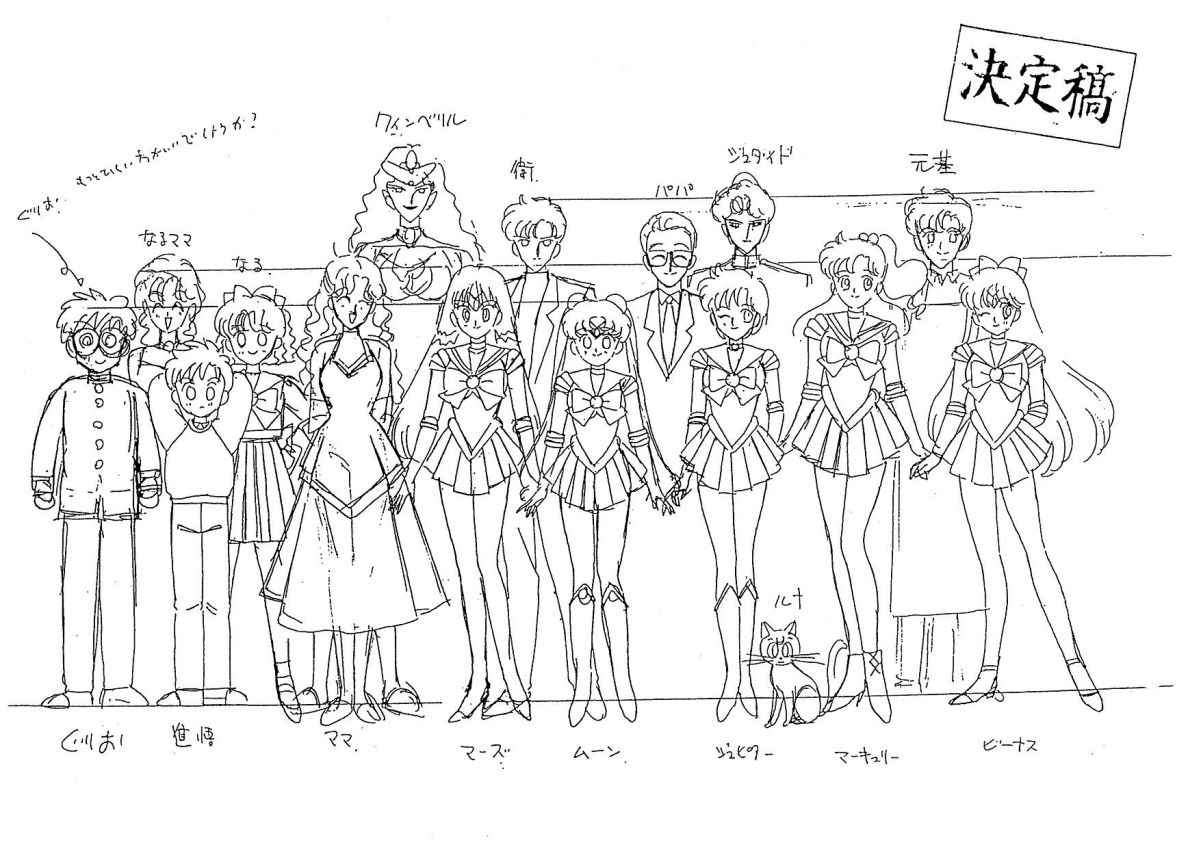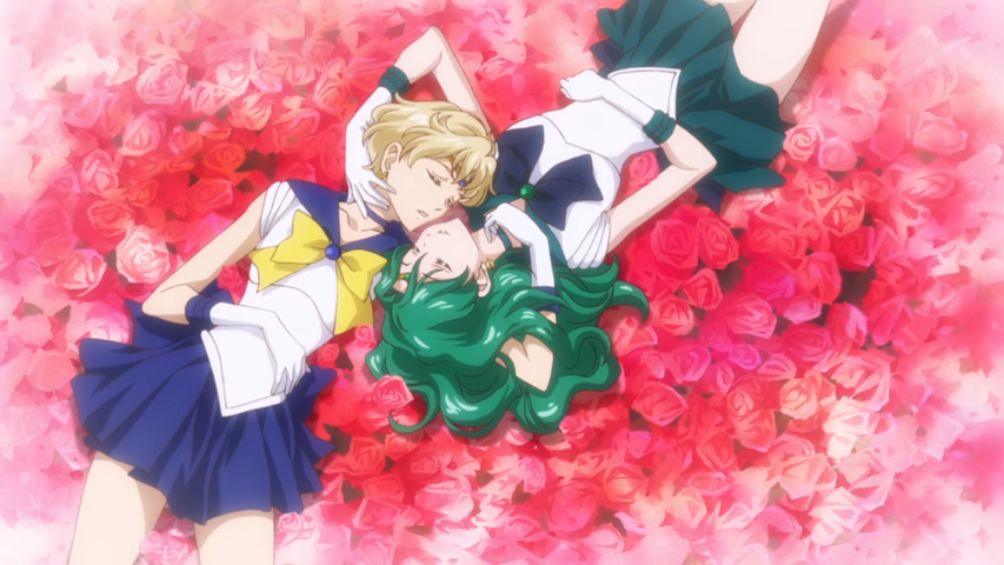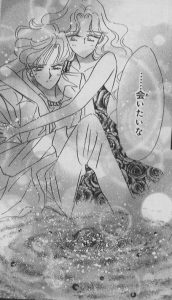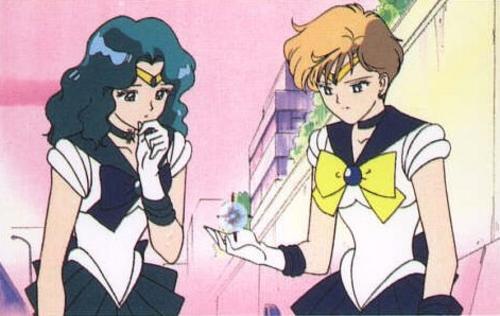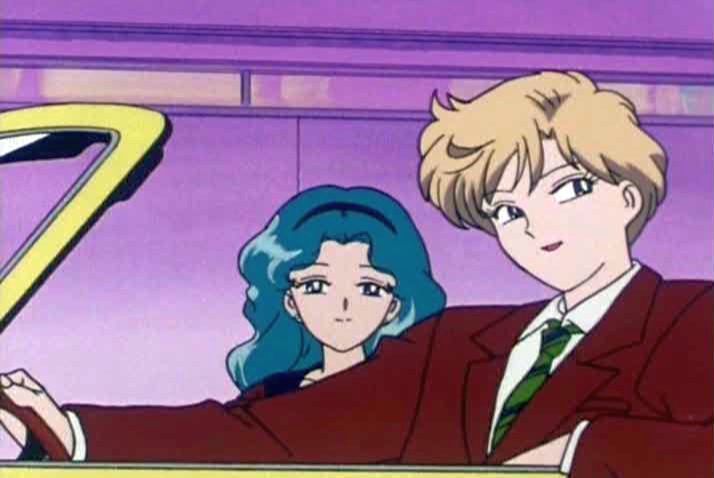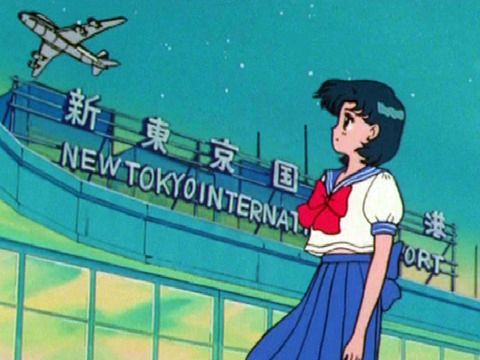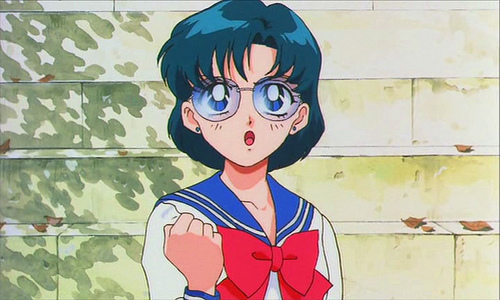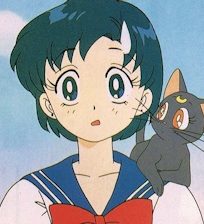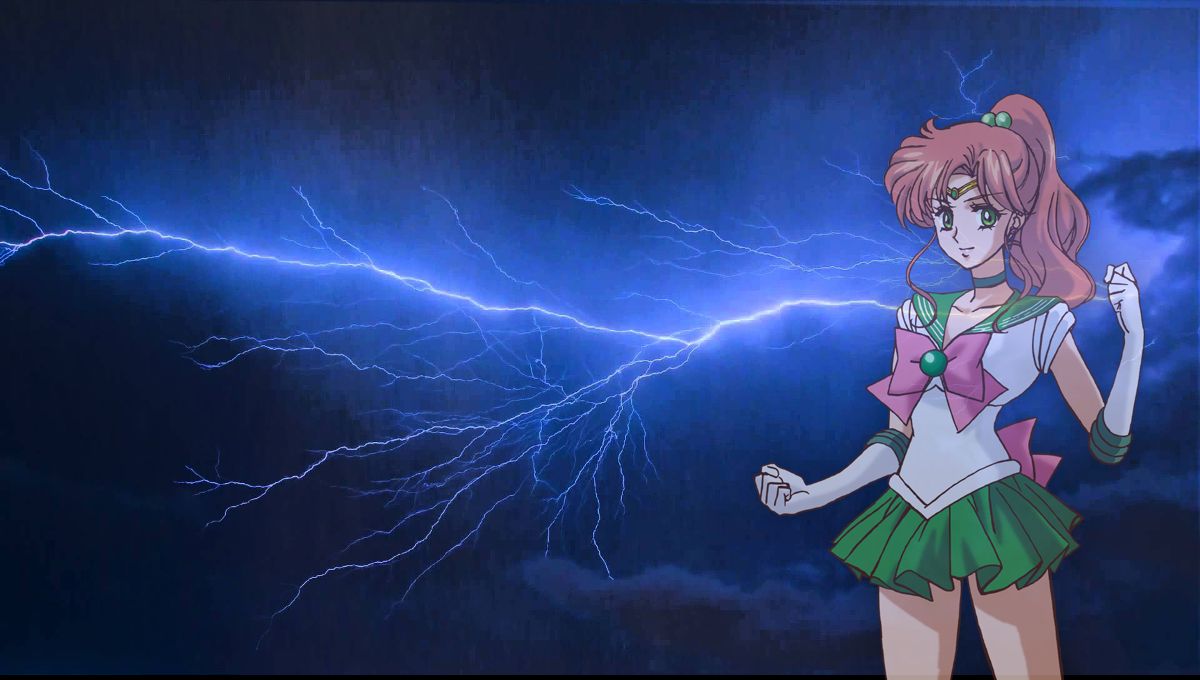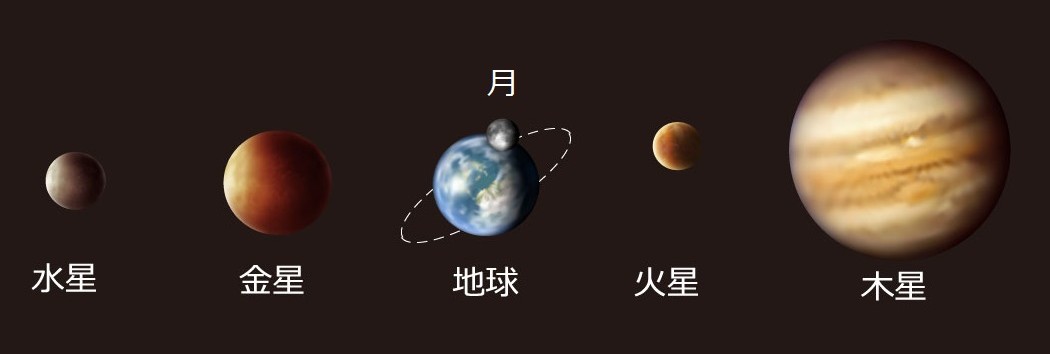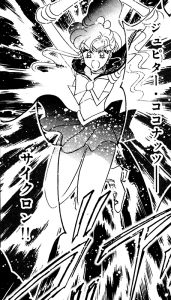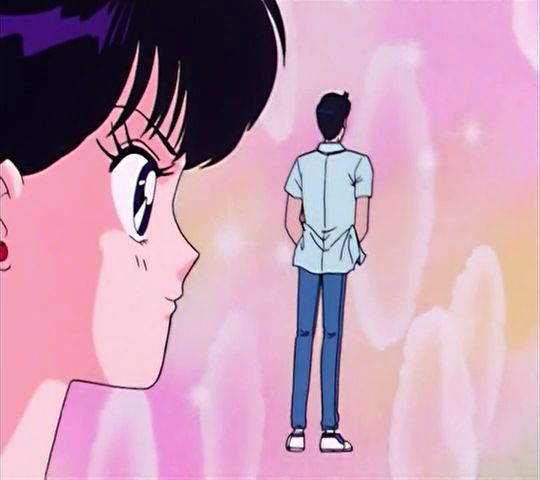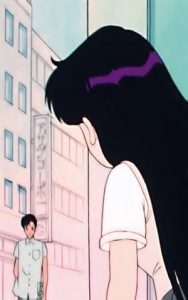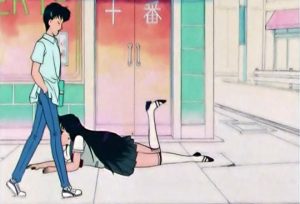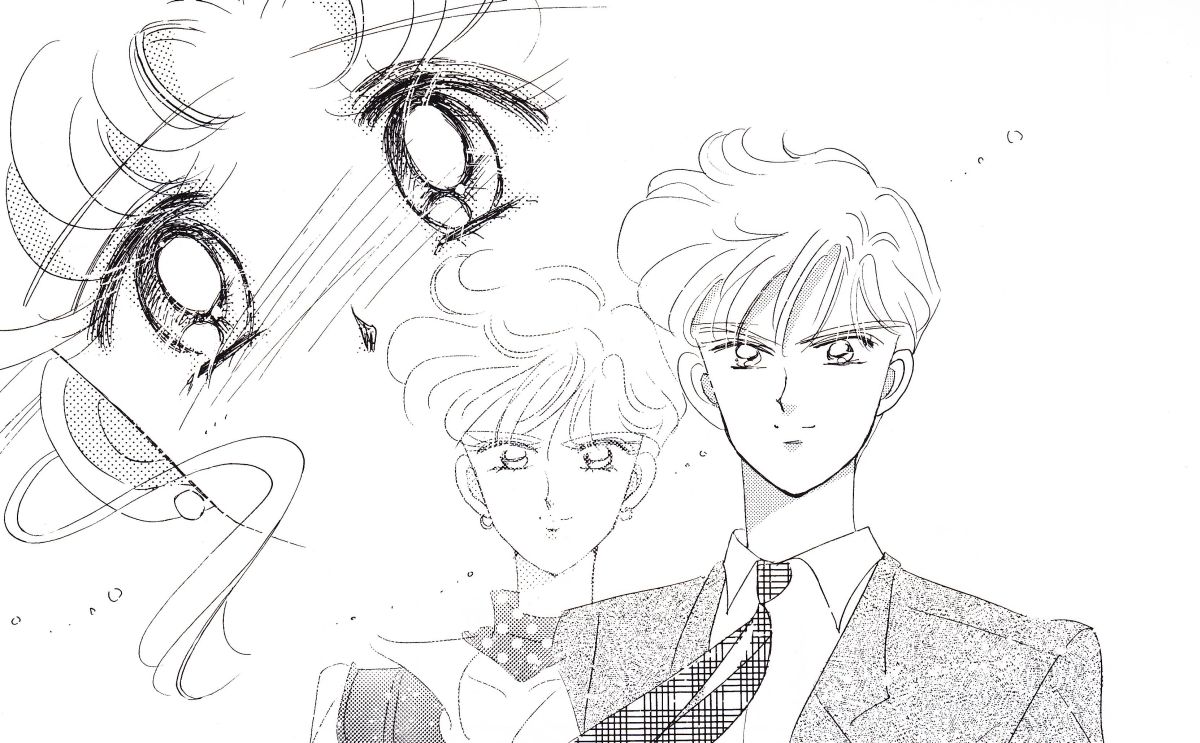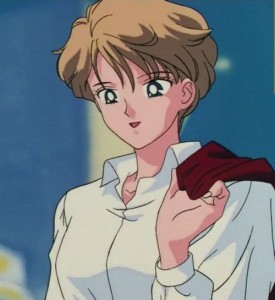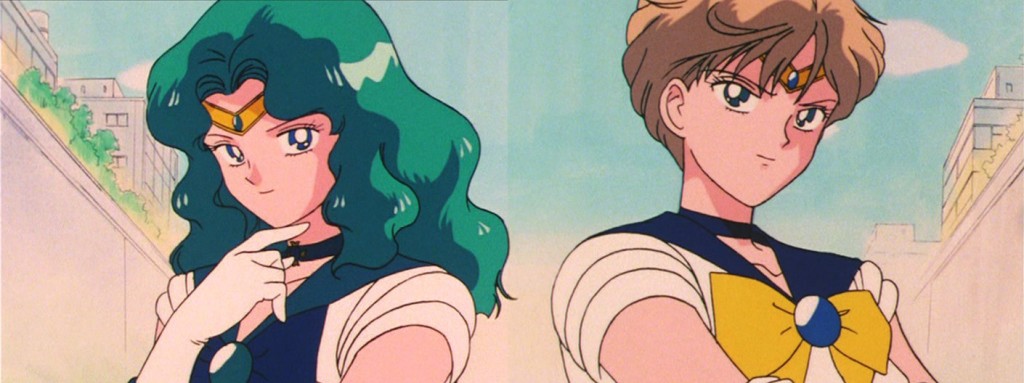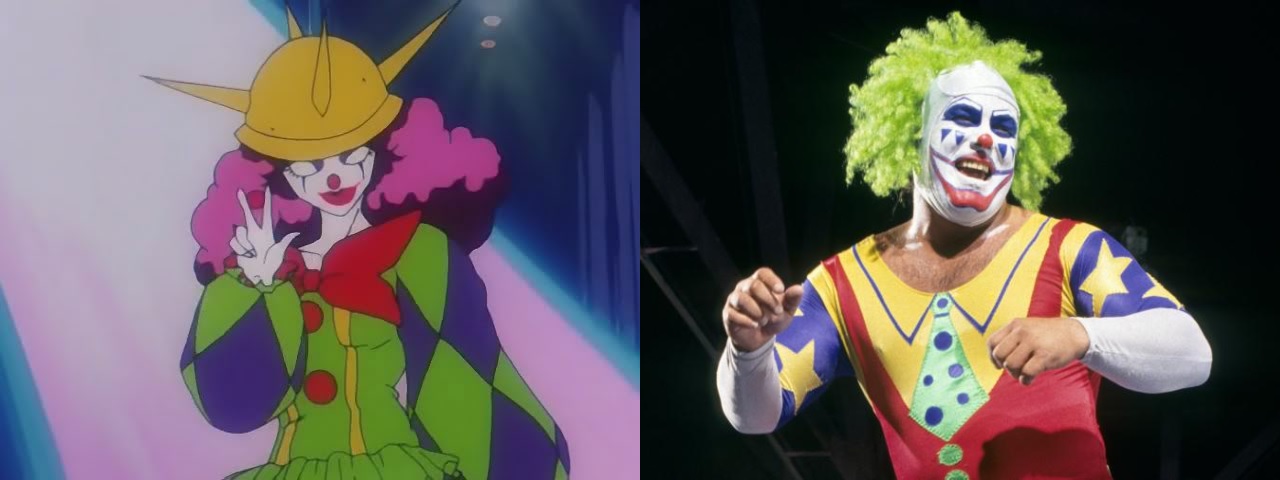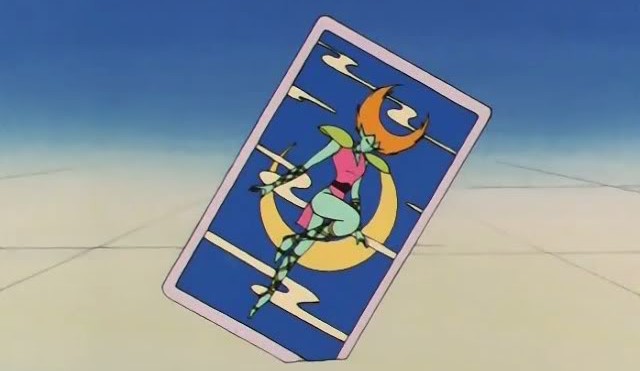If we were talking about the real world, of course it would be silly to ask the question of whether or not a second-year junior high school girl grew taller as she got older, but we’re talking about an anime/manga where characters have all manners of hair colors and are named after rabbits, so nothing should be taken for granted. For the sake of convenience, we’re going to be restricting our discussion today to only the anime since the manga both lacks the hard numbers that we need and also tends to be a little bit more liberal in the character designs from scene to scene. But for the purposes of our discussion – namely, whether Usagi actually grew physically (though emotionally is another story!) throughout the series – we should have more than enough information to answer that.
Tag Archives: Anime
Were Haruka and Michiru Viewed as Lesbians in 1990s Japan?
As Sailor Moon‘s popularity began to pick up in the west, and the decision ultimately came down to not continue dubbing the series (despite efforts from the fans), the fans started to reach out on the early internet for more information about the undubbed seasons and about the other, mysterious Sailor Soldiers. Fans went back and forth on the nature of the relationship between the little-known Sailor Uranus and Sailor Neptune – both women! – with people going so far as to make up lies about fake origins, gender transformations, and more.1
Though the dust has ultimately settled and, with the more direct statements in the Sailor Moon Crystal, both fans and creators can agree that they are clearly a lesbian couple now,2 this still leaves it unclear as to how their relationship was viewed in Japan. After all, if there was so much confusion in the US, wouldn’t it be natural for there to be confusion in Japan as well?
While it’s difficult to say what a country believed as a whole, I’m basing much of my statements on an article published by Newtype,3 one of the top three anime magazines in Japan. This article was published shortly after episode 126 of the anime aired,4 presumed to be the end of Haruka and Michiru’s story line. The title of the article is:
“Farewell to the Soldiers of Love – The Dramatic Tale of the Soldiers of Forlorn Love, Haruka & Michiru, Comes to an End”
The article is a bit long to provide the English and Japanese in their entirety, but the following is a translation of the relevant parts where the author describes his/her interpretation of episode 110.5
“Neptune, took the bullet from Eudial in order to save Uranus’ life. Uranus took her own life with the gun that was used to shoot Neptune. Didn’t you [the staff charged with creating episode 110] find this to be just a little sexy, in addition to its seriousness?”
“I would like you to read the following as just one interpretation of dramatic expression, as that is all it is. Thinking of this in a Freudian manner, a gun is symbolic of male genitalia. Though they appear to be lovers, neither of them has male genitals. Is there some meaning to the fact that the more feminine Neptune took the shot of her own will while the masculine Uranus shot herself of her own will (that’s right, the one who shot and the one to be shot couldn’t be reversed!)? Then, a symbolic so-called gun comes between the two of them (who do not have any male genitalia) and “talismans” are born from their bodies after they have been shot through. Almost as if a child had been born from within them…”
“The relationship between the two of them is reminiscent of the love between a man and a woman, but it was a deeper connection between spirits that was somehow even stronger than that. I think this scene was drawn out amazingly, with a hidden subtext of sexual symbolism of the depth of their relationship.”
The author manages to say both a lot and nothing at the same time, which makes it a bit difficult to interpret. Ultimately, though, I think the takeaway that you can get from this article is that if one of the biggest Japanese anime magazines was talking so frankly about the relationship, it’s fair to say that the general consensus among anime fans at the time was that there was some sort of sexual relationship between the two (even if some people chose to read into it in a Freudian manner).
Considering how important the rise to prominence of homosexual and transgendered characters was to fans in the west,6 I’m glad to see that it was seen similarly in Japan and hope that it had similar impacts. Though the anime certainly did downplay Haruka’s mixing of genders, the message seems to have gotten across fairly well, as showcased in a tagline underneath a screenshot on the same page:
“Michiru casually responds ‘Well then…’ to Haruka’s risque line of ‘I’m not letting you go home tonight.’ This was a meaningful scene that only the two of them could have.”
As for the sexuality of the other Sailor Soldiers? Well, fan theories are abound and the jury is still out, but it’s at least nice to get a glimpse into what Japanese fans thought of Haruka and Michiru’s relationship back in 1995! This does bring one question to mind, though: did the anime really do less to advance the obviousness relationship, or possibly more? As I re-watch the series, they definitely didn’t shy from anything! What do you think?
What is the Connection Between Ami’s Mother and Germany?
While there’s certainly nothing particularly notable in fiction about a main member of the cast (successfully or unsuccessfully) having to move away, Ami’s sudden announcement in the anime1 that she would be going to Germany of all places for her study abroad comes off as a bit random. Moreover, her reasoning – that she wants to be a doctor like her mother – seems completely unrelated. But what’s interesting about this is that while Ami’s sudden desire to go to Deutschland may seem completely random to Sailor Moon fans in the west, it actually made a lot of sense, and even seemed natural, to Japanese fans.
First, a little background on what is strange about Ami going to Germany.
In Japan, every student is required to study English for at least three years in junior high school, though most will study for six, with an additional three years in high school (though high school is not included in compulsory education in Japan).2 Though much can be said about the quality of English education in Japan,3 high scores (on tests, at least) are still seen as important by – and are even required for entering – some of the biggest companies and universities in Japan. With that in mind, why would someone as scholastically focused as Ami choose to go to Germany and not an English-speaking country?
This is where Ami’s mother and, more importantly, her career comes in. Up until around the 1990s, when digital/electronic records started to take over, it was common practice for Japanese doctors to jot down their notes and transcribe information in the patient’s chart regarding their status not in Japanese, but in German. Even the Japanese word for “patient chart,” カルテ (karute), comes from the German word karte.4
Now why would they do that? Well, the reason is two fold. First, many of the Japanese words for medical ailments and conditions involve uncommon kanji and, when the word has been borrowed, it would make more sense to write the foreign word rather than a string of katakana to spell it phonetically. Second, it was written in German to keep the patient from reading their own records.
Actively trying to keep a patient from reading their own medical records may sound like lunacy (or even malpractice!) from a 21st century, western point of view, but Japanese media is rife with scenes of a relative dying of some grave illness and only the family being told of how much longer the patient has to live. Informed consent5 wasn’t even required under any Japanese laws until the Medical Care Act6 was revised to include it in 1997. By writing the records in German, it was nearly guaranteed that the patient wouldn’t understand their own prognosis without the doctor to explain.
Though this tradition has mostly gone by the wayside now thanks to electronic records and hospitals generally informing patients of their own medical conditions, in 1993 when this episode aired, that would definitely have still been the case, and thus it would have only been natural that Ami would want to get a head start on studying German so that she could follow in her mother’s footsteps as a doctor.
Though obviously the anime wouldn’t have dared to get rid of Ami (especially considering her popularity), I still would have loved to see her away from the team for a few episodes, or even show her experiencing Germany before coming back. There is one question that’s always bothered me, though: when Ami ultimately does become a doctor, what kind of doctor would she be?
What is Sailor Jupiter’s True Element – Lightning or Wood?
Despite being one of the five (six, if you count Mamoru / Tuxedo Mask) main original cast members, and the fourth Sailor Soldier to join the team, there’s a lot about Makoto’s back story that’s left untold. Not only does her background suggest that she was very possibly a member of a gang, but we were often left hanging wondering if we would ever find out about her mysterious ex-boyfriend/sempai or if she’d ever find a new love interest to get her mind off of him. But what we’re here to talk about to day is another one of those mysteries that has stymied Sailor Moon fans for decades: just why is it that Sailor Jupiter – the Sailor Soldier of thunder/lightning – also have wood/plant elemental attacks?
Well… actually, no. It turns out that this is yet another case of needing to re-frame the question to help us understand what the real issue is and to arrive at the right answer. As we’ve previously discussed, each of the Sailor Soldiers’ names from from the Japanese name for the planet their affiliated with, which also neatly gives them an elemental association. In the case of Ami Mizuno, for example, the Mizu in her name comes from the kanji for water (水; mizu, sui)1 which is incidentally also the kanji used to represent the planet Mercury (水星; suisei)2 in Japanese.
So what about Makoto then? Well, her last name Kino is made up of the kanji for trees (木; ki, moku)3 which ties back into the kanji used to represent the planet Jupiter (木星; mokusei).4 What this tells us is that it’s likely that Makoto’s primary element is actually supposed to be wood/plants and in fact the lightning attack is actually the abnormality. But before we can say that for a fact, we need to consider why this would be.
Why give Sailor Jupiter a lightning attack at all, you ask? Well, quite simply, one of the most memorable features of the planet Jupiter is its turbulent weather system, leading to violent thunderstorms as large as 1,000km across.5 Zeus and Jupiter, of Greco-Roman mythologies, were also known for throwing lightning bolts.6 When choosing an attack for the Sailor Soldier of the planet Jupiter, it’s hard to argue that her Supreme Thunder didn’t fit the role nicely.
However, as the series progressed, you can see that Ms. Takeuchi actually stuck with using purely wood/plant-based attacks going forward, with the single exception of Jupiter Thunderbolt.7 From thereon, we had (together with its first appearance):
- Flower Hurricane (Act 5)
- Sparkling Wide Pressure (Act 16)
- Jupiter Coconut Cyclone (Act 27)
- Jupiter Oak Evolution (Act 42)
The anime, however, seemed to prefer the electricity theme and continue to go with it whenever new attacks were created, though they sometimes implemented the manga attacks as well, which is what leads to some of the confusion.
So there you have it! As it turns out, Sailor Jupiter’s proper element should actually be over plants and nature, though due to a little creative thinking on Ms. Takeuchi’s part when it came to making her first attack, there’s been some long-term confusion as to which she really should have command over. Minako also has a similar issue with regard to metal and love, though that is another discussion for another time.
What about you? Do you prefer Sailor Jupiter as the Sailor Soldier of thunder and lightning, or do you see her more as backed by the power of plants and nature? I’d love to hear your thoughts!
Why Did Rei Pursue Mamoru in the Anime?
While there are quite a few differences between Rei in the anime and the manga, one of the more striking differences between the two is the storyline where Rei and Mamoru briefly dated in the first season of the Sailor Moon anime. Though Mamoru himself was no stranger to differences between the two mediums, how it is that the cool, mysterious, and boy-hating1 (!) Rei from the manga went so far into the opposite direction and ended up pursuing Mamoru so aggressively is more than a bit out of character for her. So how did this wind up happening and what does this tell us about Rei’s character in the anime?
Rei’s reasons for pursuing Mamoru were actually pretty simple (some would say superficial, but I’m not one to judge). According to Rei:2
「ルックスがよくて、いい学校に行っていて、お金持ちだから」
“He’s attractive, going to a good school, and is rich.”
More than likely, this is in reference to what is known in Japanese as 三高 (sankou; the three highs): high salary, high-class education, and physical height.3 During the bubble economy4 – from the late 80’s to early 90’s – these attributes were said to be what was most valued by Japanese women when choosing a potential boyfriend or future husband. From Rei’s point of view, as the daughter of a politician and a student at an elite private school, it was only natural that Mamoru would make a good match for her. It’s possible, I suppose, that she could also sense Mamoru and Usagi’s budding feelings for each other and this was meant to be antagonistic, but that’s just speculation and I really don’t see Rei as that type of person.
Perhaps the greatest source of information on (anime) Rei’s outlook on love and romance comes from an interview5 with Michie Tomizawa, Iriya Azuma, and Sukehiro Tomita (Rei’s voice actress and Sailor Moon‘s producer and scenario writer, respectively). In it, the producer (Azuma) admits that Rei and Michie have the strongest resemblance between all of the voice actresses of their respective characters, and even that the animation staff often sit in on the post-recordings and take notes for how to evolve the characters.
Newtype: 「シリーズが進むうちに、レイちゃんと富沢さんの性格が接近してきたということですね。」
Azuma: 「ええ。スタッフも、アフレコなどでよく声優さんを観察していますから・・・あっ、似てきたといっても、富沢さんがイジワルだってわけじゃないですよ(笑)。」Newtype: “So Rei and Ms. Tomizawa’s personalities are getting more and more alike as the series progresses.”
Azuma: “That’s right. The staff is often watching the voice actresses during the post-recordings, you see. Well, it’s not like Ms. Tomizawa is ill-tempered or anything! (laugh)”
Later in the interview, Ms. Tomizawa discusses the brief relationship between Rei and Mamoru, describing it as Rei mistaking her feelings of admiration for Mamoru for romantic love. Even more interesting, and possibly even more relevant to Rei’s feelings towards love with regard to Yuichiro, Ms. Tomizawa describes herself as:
Tomizawa: 「 ・・・わたし、子供のころからずっとスポーツギャルで、仲のいい男の子の友達もいっぱいいたんですけど、好きになった人に対しては口もきけないようなタイプでした。」
Tomizawa: “… I’ve always been a sporty girl and have had lots of male friends ever since I was a child, but when it comes to people I liked, I couldn’t talk to them.”
This may help explain her completely different approaches toward her relationships with Mamoru and Yuichiro, wherein she directly pursues Mamoru but seems to interact with him more like a friend, particularly in the Sailor Moon R anime where she can occasionally be seen spending time together with Mamoru and ChibiUsa, while completely ignoring or even yelling at Yuichiro. Further discussion on her relationship with him, however, will have to wait for another time!
Whether you love or hate the way Rei differed in the anime and manga, she did serve as an interesting foil in the series to play against Usagi and even helped bring out some of Usagi’s feelings toward Mamoru prior to the big Tuxedo Mask reveal (something which fans often describe as happening too fast in the manga). It’s interesting to see that a lot of this actually came about from Ms. Tomizawa’s take on the character and how the production staff chose to adapt Rei’s personality to match the person providing her voice (both literally and figuratively)!
Did the Sailor Moon Anime Make Haruka More Masculine?
I generally try to avoid topics that require an understanding of Japanese to begin with, since it’s much less fun for those involved and has a very “inside baseball”1 feel to it if you’re trying to follow along with a bunch of different terminology. Of course, it can be very interesting sometimes and since we’re talking about a series which has undergone many incarnations in being brought to the Western world, it definitely is worth discussing sometimes. The case of Haruka, and how her gender and sexuality is conveyed in the anime and manga, is certainly one of those issues worth a closer look.
Japanese, as I’m sure many of you are aware, has a lot of personal pronouns.2 In fact, if you take a look on the Japanese Wikipedia page,3 you’ll find that they list fifty-one different ways to say “I” or “me.” This leads to an interesting problem in translation, since in Japanese these all express information on the way that the speaker views both themselves and their relationship with the listener while there’s no other choice than to translate them all as “I” when putting it into English.4 While most anime fans have undoubtedly heard of the common terms like watashi, atashi, boku, and ore, there are many others like honshoku (本職; used in business correspondence, often by government officials) and wagahai (我が輩; used by kingly sorts and despots, like King Koopa from Super Mario and well known in the title of “I Am a Cat” by Natsume Soseki5) which, though slightly less common, are just as important to Japanese culture and communication.
So when it comes to Haruka, it’s obviously a great point of interest how she refers to herself, since it expresses a part of her character that doesn’t really come across in English. While researching this, though, I came across an interesting issue: the anime and the manga treat Haruka’s use of personal pronouns differently… and in a pretty peculiar way.
How does the anime treat it? Well, irrespective of whether she is Sailor Uranus or Haruka (and both before and after Usagi discovers Haruka is female), she refers to herself using the pronoun boku, which is typically reserved for males but is not seen as completely verboten when used by younger girls and up through university. Where things get interesting, though, is in the manga. Ms. Takeuchi did not stick to just one personal pronoun for the character, but actually uses two – atashi and ore, which are seen as explicitly feminine and masculine, respectively. So when appearing as Haruka, she identifies herself more as a masculine and strong personality while taking on more of a feminine touch (on the same level as the way Ami refers to herself!) when in the form of Sailor Uranus.
To be honest, I’m rather disappointed that the anime did away with this for a simple across-the-board use of boku rather than going through the effort of trying to show Haruka as more of a fluid character, transcending above the simple male/female gender choice, as Ms. Takeuchi hinted at in the manga by switching between two extremes.
Ultimately, this is all a relatively minor issue, but it’s unfortunately one that’s lost in translation since there really aren’t any direct ways to address it in English other than changing the rest of the character’s speech patterns. I’d love to hear about how other translations dealt with it, though. Especially ones which do have gendered pronouns!
How Did Ail and An’s Cardians Get Their Names?
While the whole Monster of the Day (MotD) concept is one of the more memorable aspects of the battles the Sailor Team take part in during their various adventures, it’s easy to forget that this was really more of an invention of the anime than anything else. This is, of course, all doubly true when it comes to the Cardian Arc of Sailor Moon R since… well… there was no corresponding story line in the manga. While in Ms. Takeuchi’s manga, many of the MotD (be they youma, droids, or otherwise) actually went unnamed since they were one-off, throwaway characters, fortunately for us it seems that the anime had a penchant for creatively (generally pun-related) names. As with the youma of the Dark Kingdom, Ail and An’s Cardians don’t disappoint with their names. Let’s take a look at where they came from!
The Cardians
It probably goes without saying, but the name “Cardian” itself is a play off of both “card” and “guardian,” though the idea of them being guardians is a bit ironic when you think about the fact that they exist to help Ail and An steal energy from humans and fight against the Sailor Soldiers. However, it you look at it from Ail and An’s point of view, I suppose you could easily consider them to be guardians of sorts! Individually, though, is where it gets interesting.
- Vampir: Due to her sucking energy (from our favorite victim, Naru!) for the Doom Tree (Makaiju), it’s pretty obvious that she got her name from the English word “vampire,” though the plant connection seems to just have been added in without any relation to the name.
- As an interesting bit of trivia, Vampir was voiced by no other than Megumi Ogata, the same voice actress who voiced Haruka Tenoh!
- Minotauron: Based obviously in both design and abilities on the Minotaur1 of Greek mythology. As for the “~ron” part of the name? This appears to be related to an obscure French term for a cut of beef between the neck and the shoulder, talon.2 You may also recognize this name from Talon, the owner of Lon Lon Ranch3 in Legend of Zelda: Ocarina of Time and beyond.
- Phalion: You’ll often see the name of this character romanized with an f (rather than a ph), but considering the character’s design appears to be based on that of a sphinx (note that this is not the Sphinx, but a sphinx – a monster in Greek mythology said to be made up of a lion’s body and a female head)4 I think that the beginning part of the name, the “Pha / Fa,” is actually a word play with Pharaoh (which is written similarly in Japanese), hence the spelling.
- Hell Ant: This is one of those Cardians that, to an English speaker, is pretty straight forward. She’s basically an ant. From hell.
- Leshy: This is another name that you’re likely to see written differently on the web, usually as “Reci.” The Japanese spelling is an exact match with the Japanese spelling for Leshy,5 a spirit of the woods from Russian fairy tales. Considering the mythological basis for the rest of the characters and that she attacks during cherry blossom season (and from a tree, no less), this seems like a more proper connection.
- Gigaros: The name is a play on both the Greek word giga– meaning huge6 and the Japanese name for Icarus.7
- Amaderasu: Continuing our mythological theme, this time the reference goes back into Japanese mythology, as this monster is pretty clearly named after Amaterasu,10 one of the first gods in the Shinto religion and the goddess of the sun. Her name may also be a play off of Amadeus, since they’re spelled so similarly in Japanese.
- Seiren: This Cardian’s name is a pretty clear connection to the Siren11 of Greek mythology. The sei part of the name, though, may be a pun in reference to the Japanese kanji for “voice” – 声 – which can be read as sei.
- Utonberino: One of those names that absolutely doesn’t localize well, this is the Japanese word for a traditional boxed lunch, 海苔弁当 (noribentou; nori boxed lunch)12 written backwards. This is obviously where the character design comes from. It’s not exactly apparent in English, but when you break it up as no-ri be-n-to-u and u-to-n-be ri-no, you can see it easier.
- Bipierrot: Named after pierrot,13 a mime of sorts in traditional French theater and the Japanese word for clown, the connection is pretty obvious. As for where the bi part of the name comes from, my best guess is that it’s the same as the one used in used in Pretty Soldier Sailor Moon (美少女戦士セーラームーン; bishoujo senshi se-ra-mu-n), since bi here means “pretty” or “beautiful” and often is used for female-related words.
- Amanju: Once again we go back to Japanese folklore for inspiration, this time to the amanojaku,17 a demon which is said to provoke one’s darkest desires. This would explain the connection with reading everyone’s minds, though judging by the horns and all, the design seems to be based off of a standard Japanese oni.18
- Yamandakka: While the appearance is obvious – an Asura19 from Buddhist mythology – the basis for her name is a bit of a mystery to me. The best possible answer I’ve been able to come up with is that it’s a play on the Japanese term for Asura which are depicted with three faces and six arms, a design known as 三面六臂 (sanmenroppi).20 If you were to yaman could be an altered reading of 四面 (four faces) and 足花 (legs, flower; read as da and ka respectively).
And there you have it! Once again, the various animators, directors, and all the staff who worked on the Sailor Moon anime don’t disappoint when it comes to making creative and interesting character names. Though some of them are a bit obvious to native English speakers, like the Ail, An, and Fiore connections, it’s nice to see all of the different mythologies tied together. And who would have known that a wrestling star would be the inspiration for a character!
